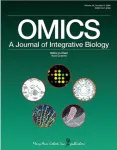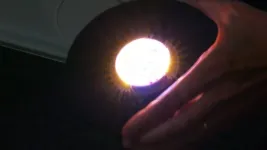(Press-News.org) Scientists have discovered that certain plants can survive stressful, dry conditions by controlling water loss through their leaves without relying on their usual mechanism - tiny pores known as ‘stomata’.
Nonstomatal control of transpiration in maize, sorghum, and proso millet – all C4 crops which are critical for global food security – gives these plants an advantage in maintaining a beneficial microclimate for photosynthesis within their leaves.
This allows the plants to absorb carbon dioxide as part of the photosynthesis and growth process, despite raised temperatures and increased atmospheric demand for water without increasing the water expenditure.
Publishing their findings today (16 Sep) in PNAS, researchers from the University of Birmingham, Australian National University, Canberra, and James Cook University, Cairns, challenge traditional understanding of plant transpiration and photosynthesis under stressful and dry growing conditions – namely that stomata alone control leaf water loss.
Co-author Dr Diego Márquez, from the University of Birmingham, commented: “This revolutionised our understanding of plant-water relations by showing that nonstomatal control of transpiration limits water loss without compromising carbon gain—challenging what is typically accepted as an unavoidable trade-off.
"Our findings have significant implications for plant adaptation to climate change and how crops might be grown in arid environments. Understanding this mechanism could open new avenues for improving water-use efficiency in C4 crops, which are vital for global food security.”
The study confirms that C4 plants maintain reduced relative humidities in the substomatal cavity, down to 80% under vapour pressure deficit (VPD) stress, reducing water loss and highlighting a critical role of nonstomatal control in water-use efficiency.
This mechanism helps plants sustain photosynthesis by reducing water loss without significantly lowering intercellular CO2 levels for photosynthesis. This is crucial for maintaining growth and ensuring that the crops thrive.
The findings also suggest that nonstomatal control mechanisms may have evolved before the divergence of C3 and C4 photosynthetic pathways, indicating a shared evolutionary trait.
"Our research reframes understanding of water-use efficiency in C4 plants and reveals that this alternative mechanism helps plants continue to grow and capture carbon dioxide, even when atmospheric water demand is high, challenging traditional assumptions about how these plants survive droughts,” added Dr Márquez.
Photosynthesis is how plants use light and carbon dioxide to make sugars for growth, using an enzyme called Rubisco. Plants use the carbon dioxide that enters through open stomata to produce sugar, whilst open stomata also let water vapour out.
While C3 plants rely only on CO2 diffusion through their stomata for carbon gain, C4 plants possess specialised leaf structures and enzymes that concentrate carbon dioxide around Rubisco, enhancing their photosynthetic performance and water-use efficiency. However, this benefit comes with a trade-off, as these plants are vulnerable to substantial photosynthesis reduction when the stomata close. Therefore, the nonstomatal mechanism is crucial in ensuring their success in controlling water loss while allowing stomata to remain open.
ENDS
For more information, interviews or an embargoed copy of the research paper, please contact University of Birmingham Press Office pressoffice@contacts.bham.ac.uk or +44 (0)121 414 2772.
Notes to editor:
The University of Birmingham is ranked amongst the world’s top 100 institutions. Its work brings people from across the world to Birmingham, including researchers, teachers and more than 8,000 international students from over 150 countries.
‘Mesophyll airspace unsaturation drives C4 plant success under vapor pressure deficit stress’ - Diego A. Márquez, Suan Chin Wong, Hilary Stuart-Williams Lucas A. Cernusakd , and Graham D. Farquhara is published by PNAS.
END
Critical crops’ alternative way to succeed in heat and drought
2024-09-16
ELSE PRESS RELEASES FROM THIS DATE:
Students with multiple marginalized identities face barriers to sports participation
2024-09-16
MINNEAPOLIS/ST. PAUL (09/16/2024) — The U.S. Department of Health and Human Services Healthy People 2030 plan sets a national objective to increase youth sports participation from 50% to 63% over the next five years. For adolescents, staying active offers benefits to their overall health and their social and academic lives. However, the number of youths participating in physical activity and sports is on the decline. While participation gaps based on single social identities ...
Purdue deep-learning innovation secures semiconductors against counterfeit chips
2024-09-16
WEST LAFAYETTE, Ind. — Researchers in Purdue University’s College of Engineering have developed a patent-pending optical counterfeit detection method for chips used in semiconductor devices.
The Purdue method is called RAPTOR, or residual attention-based processing of tampered optical responses. It leverages deep learning to identify tampering. It improves upon traditional methods, which face challenges in scalability and discriminating between natural degradation and adversarial tampering.
Alexander Kildishev, professor in the Elmore ...
Will digital health meet precision medicine? A new systematic review says it is about time
2024-09-16
A new systematic review of pharmacogenomics clinical decision support systems used in clinical practice in the peer-reviewed OMICS: A Journal of Integrative Biology suggests that these e-health tools can help accelerate pharmacogenomics, precision/personalized medicine, and digital health emergence in everyday clinical practice worldwide. Click here to read the article now.
Anastasia Farmaki, MSc, from the Centre for Research and Technology Hellas, Thessaloniki, and coauthors in Greece, conducted a systematic review that examined and mapped the pharmacogenomics-clinical decision support ...
Improving eye tracking to assess brain disorders
2024-09-16
A University of Houston engineering team has developed wearable sensors to examine eye movement to assess brain disorders or damage to the brain. Many brain diseases and problems show up as eye symptoms, often before other symptoms appear.
You see, eyes are not merely a window into the soul, as poets would have it. These incredibly precious organs are also an extension of the brain and can provide early warning signs of brain-related disorders and information on what causes them. Examining the eyes can also help track the progression and symptoms of physical and mental shocks to the brain.
Researchers say ...
Hebrew University’s professor Haitham Amal is among a large $17 million grant consortium for pioneering autism research
2024-09-16
Hebrew University of Jerusalem is proud to announce that Professor Haitham Amal is among a large $17M grant consortium for pioneering autism research. This grant is part of an American funding initiative awarded by the California Institute for Regenerative Medicine (CIRM), aimed at advancing cutting-edge autism studies.
A world-renowned expert in nitric oxide and brain disorders, Professor Amal has made groundbreaking discoveries in autism research. His team was the first to identify a direct link between nitric oxide levels in the brain and autism spectrum disorder (ASD), a finding with profound implications for the ...
Scientists mix sky’s splendid hues to reset circadian clocks
2024-09-16
Those mesmerizing blue and orange hues in the sky at the start and end of a sunny day might have an essential role in setting humans’ internal clocks.
In new research from the University of Washington in Seattle, a novel LED light that emits alternating wavelengths of orange and blue outpaced two other light devices in advancing melatonin levels in a small group of study participants.
Published in the Journal of Biological Rhythms, the finding appears to establish a new benchmark in humans’ ability to influence their circadian rhythms, and reflects an effective new approach to counteract seasonal affective disorder (SAD).
A ...
Society for Neuroscience 2024 Outstanding Career and Research Achievements
2024-09-16
Embargoed until Monday, September 16, noon EDT Contact: development@sfn.org
CHICAGO – The Society of Neuroscience (SfN) will honor leading researchers whose groundbreaking work has transformed neuroscience — including the understanding of pain, addiction, stress, synaptic transport, vision, and sleep — with this year’s Outstanding Career and Research Achievement Awards. The awards will be presented during SfN’s annual ...
Society for Neuroscience 2024 Early Career Scientists’ Achievements and Research Awards
2024-09-16
Embargoed until Monday, September 16, noon EDT Contact: development@sfn.org
CHICAGO – The Society for Neuroscience (SfN) will honor nine early career researchers whose work will be presented during Neuroscience 2024, SfN's annual meeting.
“Early career researchers are often the ones who bring fresh ideas and perspectives to the field,” said SfN President Marina Picciotto. “These awardees and their novel approaches to microscopy, machine learning, circuits and behavior ...
Society for Neuroscience 2024 Education and Outreach Awards
2024-09-16
Embargoed until Monday, September 16, noon EDT Contact: development@sfn.org
CHICAGO – The Society for Neuroscience (SfN) will present six neuroscientists with this year’s Science Education and Outreach Awards, comprising the Award for Education in Neuroscience, the Science Educator Award, and the Next Generation Awards. The awards will be presented during SfN’s annual meeting.
“The Society is honored to recognize these passionate neuroscientists ...
Society for Neuroscience 2024 Promotion of Women in Neuroscience Awards
2024-09-16
Embargoed until Monday, September 16, noon EDT Contact: development@sfn.org
CHICAGO — The Society for Neuroscience (SfN) will honor seven researchers who have made significant contributions to the advancement of women in neuroscience. The awards will be presented during Neuroscience 2024, SfN's annual meeting.
“Neuroscience is both a field of research and a community of researchers,” said SfN President Marina Picciotto. “These awardees not only advance our field’s understanding of the brain through their own research, they strengthen and support ...

